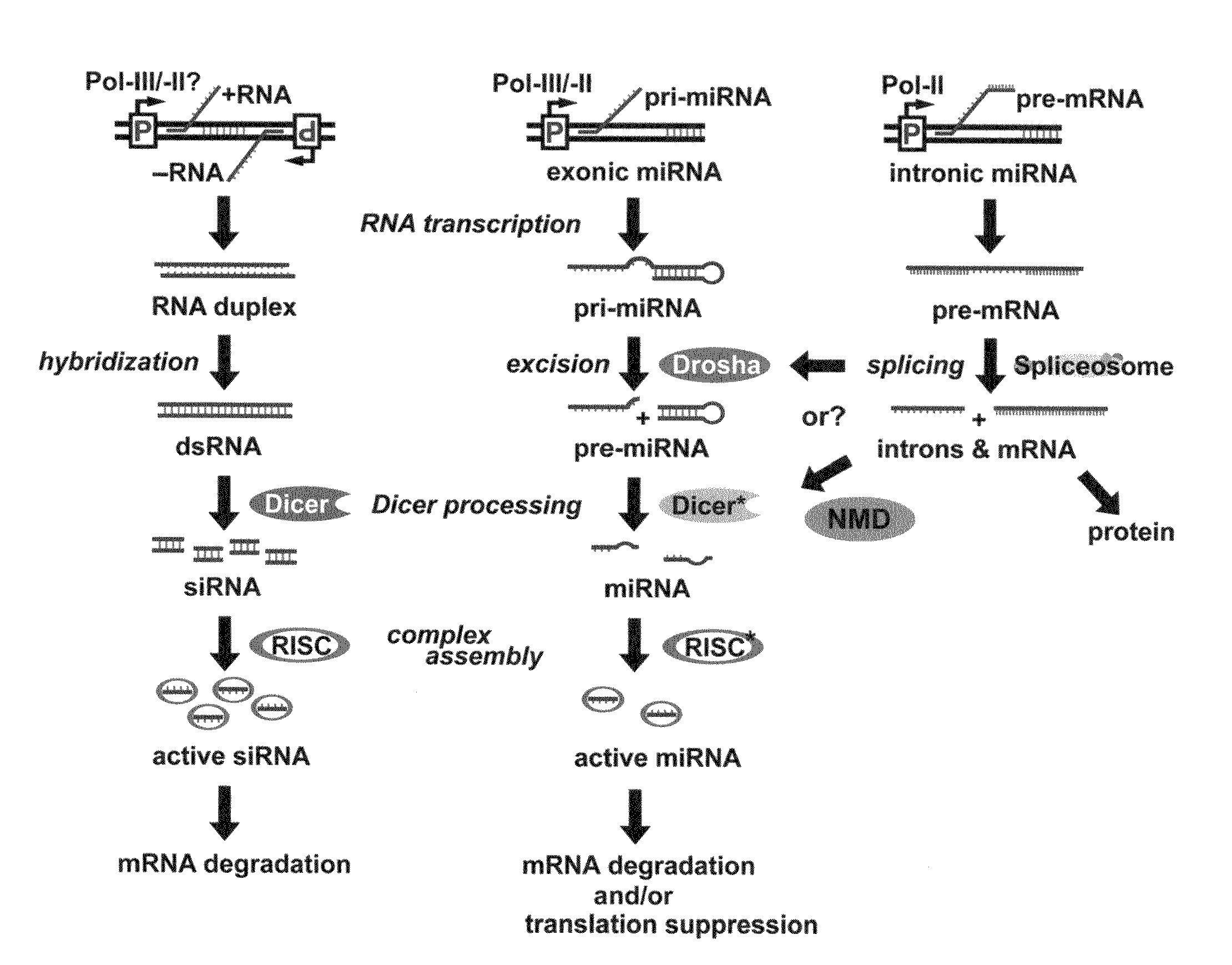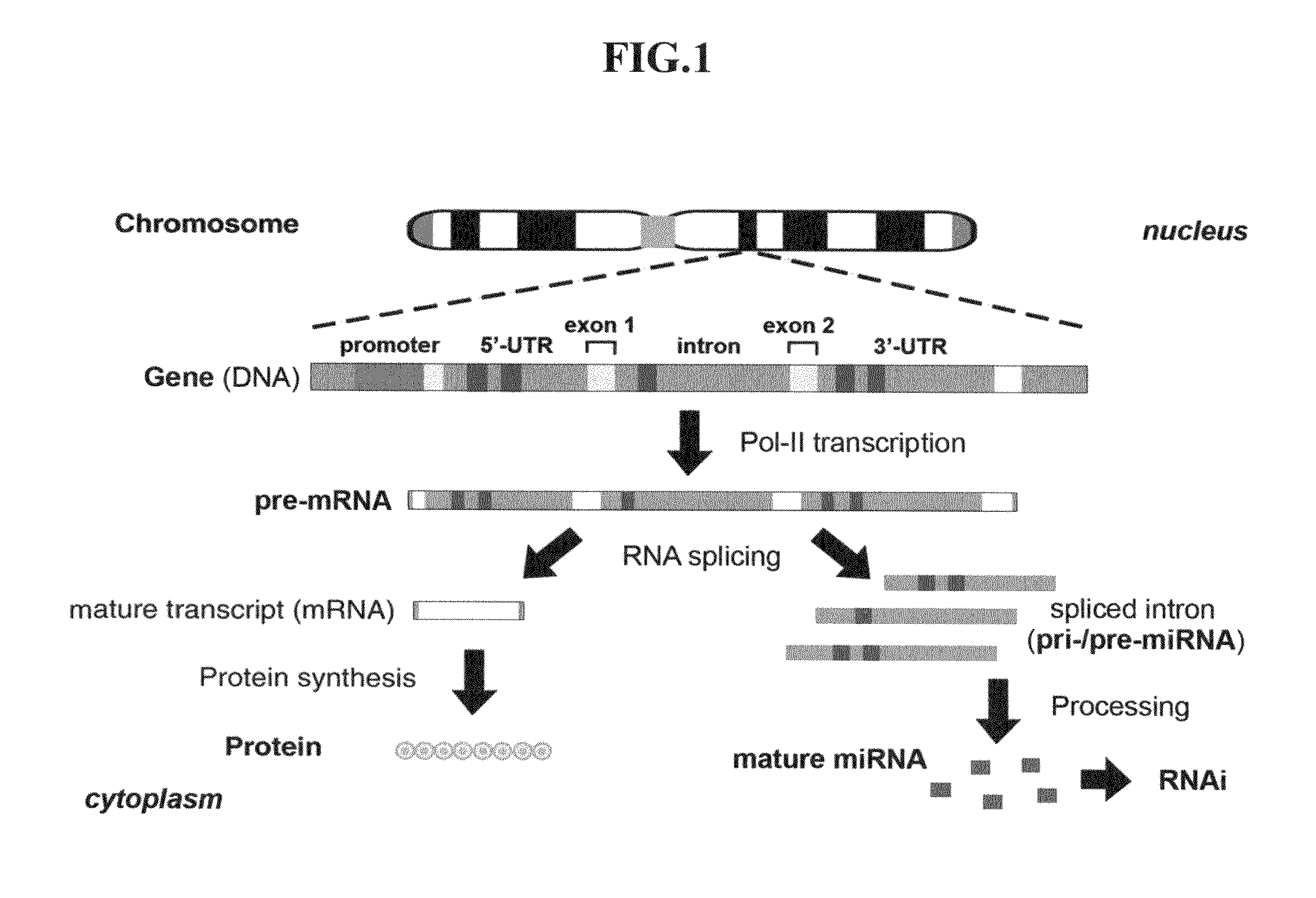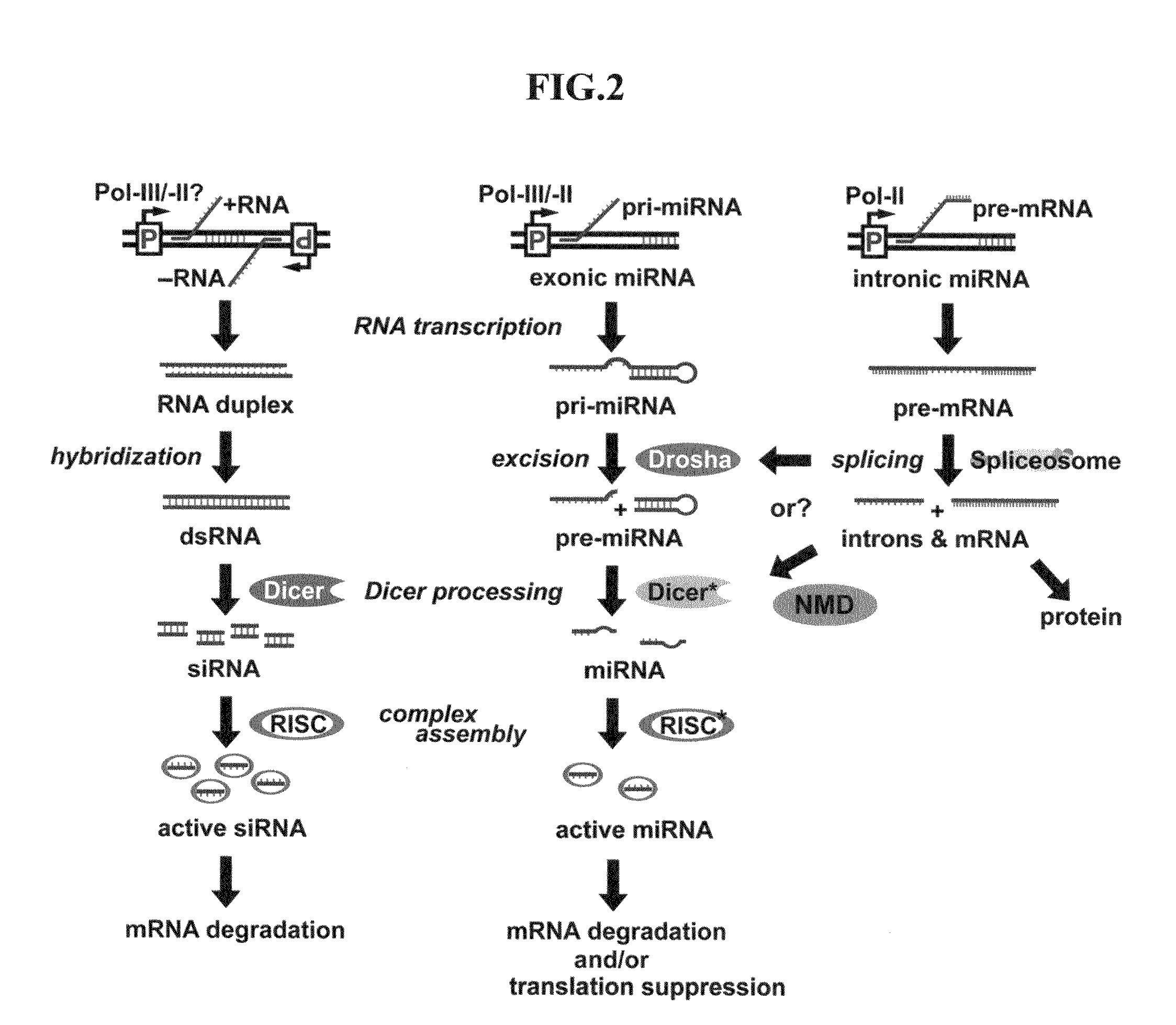Novel cosmetic designs and products using intronic RNA
a technology of intronic rna and cosmetic products, which is applied in the field of skin care cosmetic products development and generation, can solve the problems of inability to induce good hypopigmentation effects, no prior art related to hyaluronidase inhibitors for wrinkle removal, and the application of such inhibitors has not been demonstrated to work constantly and safely in higher vertebrates, including fish, avian, mammal and human. it inhibits the sirna gene silencing effect,
- Summary
- Abstract
- Description
- Claims
- Application Information
AI Technical Summary
Benefits of technology
Problems solved by technology
Method used
Image
Examples
example 1
Construction of SPRNAi-Containing Recombinant Gene (SpRNAi-RGFP)
[0112]Synthetic nucleic acid sequences used for generation of three different SpRNAi introns containing either sense-, antisense- or hairpin-EGFP insert were listed as follows: N1-sense, 5′-pGTAAGAGGAT CCGATCGCAG GAGCGCACCA TCTTCTTCAA GA-3′ (SEQ.ID.NO. 12); N1-antisense, 5′-pCGCGTCTTGA AGAAGATGGT GCGCTCCTGC GATCGGATCC TCTTAC-3′ (SEQ.ID.NO.13); N2-sense, 5′-pGTAAGAGGAT CCGATCGCTT GAAGAAGATG GTGCGCTCCT GA-3′ (SEQ.ID.NO.14); N2-antisense, 5′-pCGCGTCAGGA GCGCACCATC TTCTTCAAGC GATCGGATCC TCTTAC-3′ (SEQ.ID.NO.15); N3-sense, 5′-pGTAAGAGGAT CCGATCGCAG GAGCGCACCA TCTTCTTCAA GTTAACTTGA AGAAGATGGT GCGCTCCTGA-3′ (SEQ.ID.NO.16); N3-antisense, 5′-pCGCGTCAGGA GCGCACCATC TTCTTCAAGT TAACTTGAAG AAGATGGTGC GCTCCTGCGA TCGGATCCTC TTAC-3′ (SEQ.ID.NO.17); N4-sense, 5′-pCGCGTTACTA ACTGGTACCT CTTCTTTTTT TTTTTGATAT CCTGCAG-3′ (SEQ.ID.NO.18); N4-antisense, 5′-pGTCCTGCAGG ATATCAAAAA AAAAAGAAGA GGTACCAGTT AGTAA-3′ (SEQ.ID.NO.19). In addition, two e...
example 2
Cloning of SpRNAi-Containing Genes into A Expression-Competent Vector
[0115]Because the recombinant SpRNAi-RGFP gene possessed an XhoI and an XbaI restriction site at its 5′- and 3′-end, respectively, it can be easily cloned into a vector with relatively cohesive ends to the XhoI and XbaI restriction sites. We mixed the SpRNAi-RGFP gene with the linearized 3,934-bp empty pHcRed1-N1 / 1 plasmid at 1:16 (w / w) ratio, cooled the mixture from 65° C. to 15° C. over a period of 50 min, and then added T4 ligase and relative buffer accordingly into the mixture for ligation at 12° C. for 12 hr. This formed an SpRNAi-RGFP expression vector, which can be propagated in an E.coli DH5α LB culture containing 50 μg / ml kanamycin (Sigma Chemical, St. Louis, Mo.). A positive clone was confirmed by PCR with the RGFP-specific primers SEQ.ID.NO.21 and SEQ.ID.NO.22 at 94° C., 1 min and then 68° C., 2 min for 30 cycles, and for further sequencing. For cloning into viral vectors, the same ligation procedure cou...
example 3
In Vivo Vector Transfection
[0117]For vector transfection into cell cultures, fish larvae and mouse skins, we first mixed the SpRNAi-RGFP expression plasmid vectors containing either anti-EGFP, miR-Tyr or miR-Hyal pre-miRNA insert with a FuGene reagent (Roche, Ind.), following the manufacturer's suggestion. Then, the mixtures were directly applied to the cell cultures (i.e. primary human skin culture), fish larvae or mouse skins, respectively. Vectors containing an insert-free RGFP gene and an SpRNAi-RGFP gene with a pre-miRNA insert against the HIV gag-p24 gene were used as negative controls. Tissue or cell morphology and fluorescence imaging was photographed at 0-, 24-, 48-, and 72-hr time points after the first transfection. For transfection to the human skins in vivo, a pre-made SpRNAi-RGFP vector solution was formed by mixing certain amounts (i.e. 1-1000 μg) of the purified SpRNAi-RGFP vector with or without either anti-EGFP, miR-Tyr or miR-Hyal pre-miRNA insert in 1 ml of autoc...
PUM
| Property | Measurement | Unit |
|---|---|---|
| concentration | aaaaa | aaaaa |
| pH | aaaaa | aaaaa |
| pH | aaaaa | aaaaa |
Abstract
Description
Claims
Application Information
 Login to View More
Login to View More - R&D
- Intellectual Property
- Life Sciences
- Materials
- Tech Scout
- Unparalleled Data Quality
- Higher Quality Content
- 60% Fewer Hallucinations
Browse by: Latest US Patents, China's latest patents, Technical Efficacy Thesaurus, Application Domain, Technology Topic, Popular Technical Reports.
© 2025 PatSnap. All rights reserved.Legal|Privacy policy|Modern Slavery Act Transparency Statement|Sitemap|About US| Contact US: help@patsnap.com



